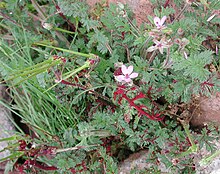| Synchytrium | |
|---|---|

| |
| Synchytrium (prob. S. papillatum) infection of Erodium cicutarium at Lookout Mountain, Phoenix, Maricopa Co., Arizona, USA. | |
| Scientific classification | |
| Domain: | Eukaryota |
| Kingdom: | Fungi |
| Division: | Chytridiomycota |
| Class: | Chytridiomycetes |
| Order: | Synchytriales |
| Family: | Synchytriaceae |
| Genus: | Synchytrium de Bary and Woronin, 1863 |
| Species | |
Synchytrium is a large genus of plant pathogens within the phylum Chytridiomycota. Species are commonly known as false rust or wart disease. Approximately 200 species are described,[1] and all are obligate parasites of angiosperms, ferns, or mosses.[2] Early species were mistakenly classified among the higher fungi (Ascomycota or Basidiomycota) because of their superficial similarity to the rust fungi. Anton de Bary and Mikhail S. Woronin recognized the true nature of these fungi and established the genus to accommodate Synchytrium taraxaci, which grows on dandelions, and S. succisae, which grows on Succisa pratensis. Synchytrium taraxaci is the type of the genus. The genus has been divided into 6 subgenera based on differences in life cycles.[1]